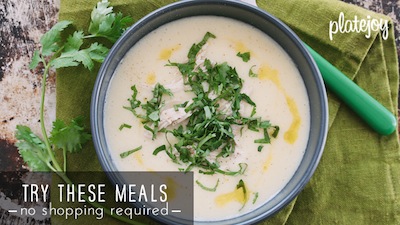A cook club. It’s like a book club, but without all the reading and the guilt of only getting through the first 30 pages. Plus, your main focus is on eating and sharing in culinary delights. Now, that’s my kind of food for thought.
Last week, I connected with fellow SF food blogger and adventure seeker, Anne Pao, for our first of many cook club gatherings. While she is not a “challenged” eater like myself – no dietary restrictions for this gal – she is always up for a dining adventure. Whether it is sucking crab meat directly from the shell or making crispy, fried spam roles at home, she is ready to give her taste buds an experience they will never forget.
After being introduced through a mutual friend, and mutually gushing over our love for the Food Network and food in general, Pao grew curious as to how one would make “no salt” taste good. More importantly, she wanted to know whether or not low sodium cooking could truly satisfy a salt-loving palette.
So the stage was set and we thought, to test her suspicion, we would dine together at a local restaurant and order the same meal – one with salt and one without – to compare notes. But budget, time, and exhaustion from the week snuck in as our dinner date approached and we decided to forgo the professional chefs and tackle the challenge ourselves, at home.
Pao graciously hosted the evening’s event at her gorgeous apartment and since she opened the doors of her kitchen to this experiment, I left the menu to her. The choice? A Puerto Rican feast complete with tostones, pig’s feet soffritto, and an octopus salad (ensalada de pulpo). For those of you who are low sodium savvy, your bells and whistles will be going off. Pigs feet, for commercial sale, are either cured or pickled, which translates to mean a whole load of sodium. And, according to the USDA, octopus has 162 mg of sodium per 1 ounce serving, so those were out of the question as well.
But even with these salty ingredients, Pao could not have picked a more perfect menu for our evening’s objective. In tackling Puerto Rican cuisine, I could not only introduce her to the flavorful side of low sodium cooking, but I could also demonstrate how easy it is to make low sodium substitutions. Instead of pig’s feet, we used pork butt, which produces a similar fatty flavor and of course, has very tender meat. Then, for the octopus, we used a rock cod and treated it like a ceviche, soaking it in blood orange juice for a few hours to make it tender and pink. As for the jar of roasted peppers, for which the recipe also called, I simply roasted my own ingredients using the broiler. And for my proudest substitution, I swapped some of my sweet pickled grapes for olives. The tang of the vinegar and the turmeric provides an unexpected punch to the sweet spice of the peppers.
Once we had our low sodium substitutes in place, Pao and I were ready to roll. A few hours of chopping, stewing, and red-wine drinking later, we had created a 3-course, Puerto Rican Feast full or fresh herbs and spice. Of course, the final product was slightly different than the original recipe, but the flavors and textures were beyond expectations. I am pretty sure Pao was pleased with the final result, since we both had seconds and thirds and polished what we had heaped onto our plates. There wasn’t much chatting once the food hit the table.
I absolutely love the opportunity to try new cuisines, discover new food combinations, and of course, meet good folk who find joy in cooking. So for your eating pleasure, here is the simple Soffritto recipe with the tostones and ceviche salad to come tomorrow.We shall see what the next challenge brings and I’m looking forward to more shared low sodium adventures to come. Pao on.
Ingredients:
- 1/4 cup of chopped cilantro
- 1 head of garlic, roughly chopped
- 3 large onions, roughly chopped
- 3 red bell peppers
- 2 poblano peppers
- 2 tomatillos
- ½ cup pickled red grapes
- 2 tbsp. crushed oregano
- 1 tsp. black pepper
- 1 tsp. cayenne pepper
- 2 tablespoons extra virgin olive oil
- 1 pound of pork butt
Directions:
1. Put 2 bell peppers, the poblanos, and the tomatillos (washed with outer leaves removed) into an oven-safe dish and broil on low for 10 minutes. Turn the peppers, poblanos, and tomatillos when one side has charred and broil for another ten minutes. Let them cool and remove the charred skin.
2. While you are waiting for the roasted peppers to cool, prepare the pork butt by cutting it into small 1/2-inch cubes. Leave most of the fat, it will add a nice flavor to the soffrito and will cook off by the time you eat the final dish.
3. In a pan, heat 1 tablespoon of olive oil and when ready, add the pork chunks. Sear both sides, about 10 minutes each.
4. Prepare the rest of the ingredients (garlic, onion, 1 bell pepper, cilantro, pickled grapes) by roughly chopping them.
5. In a large pot, heat the other tablespoon of olive oil over medium-high heat and add garlic and onion. Saute until slightly browned, about 5 minutes, and then add the roasted pepper, bell pepper, cilantro, and pickled grapes.
6. With an immersion blender, puree the ingredients until as smooth as you desire. Traditonal soffritos tend to be chunkier, so there is not right or wrong consistency here.
7. Add the pork butt and allow the stew to come to a boil.
8. Once it has begun to bubble, reduce to a simmer (medium heat) and cover pot. Cook for another hour until the meat is tender. Serve over rice – we flavored our white rice with cilantro and olive oil, but you can also enhance the dish with saffron and Safflower oil.











Yes! Love the post! Now I need to get rolling on submitting my ownon SF Tao of Pao. Can’t wait for the next feast.